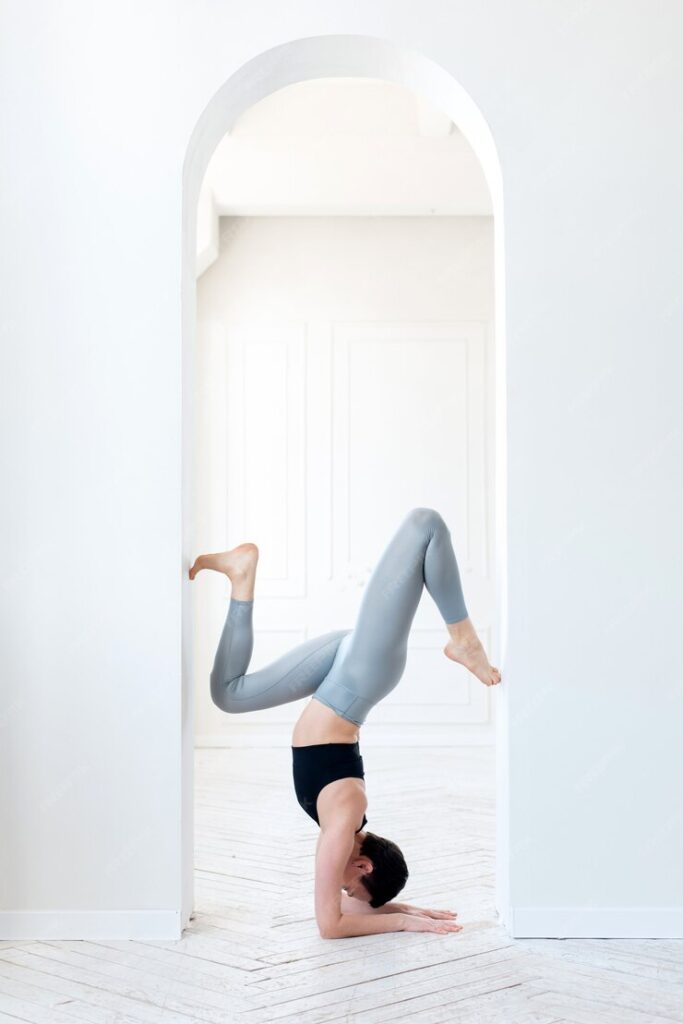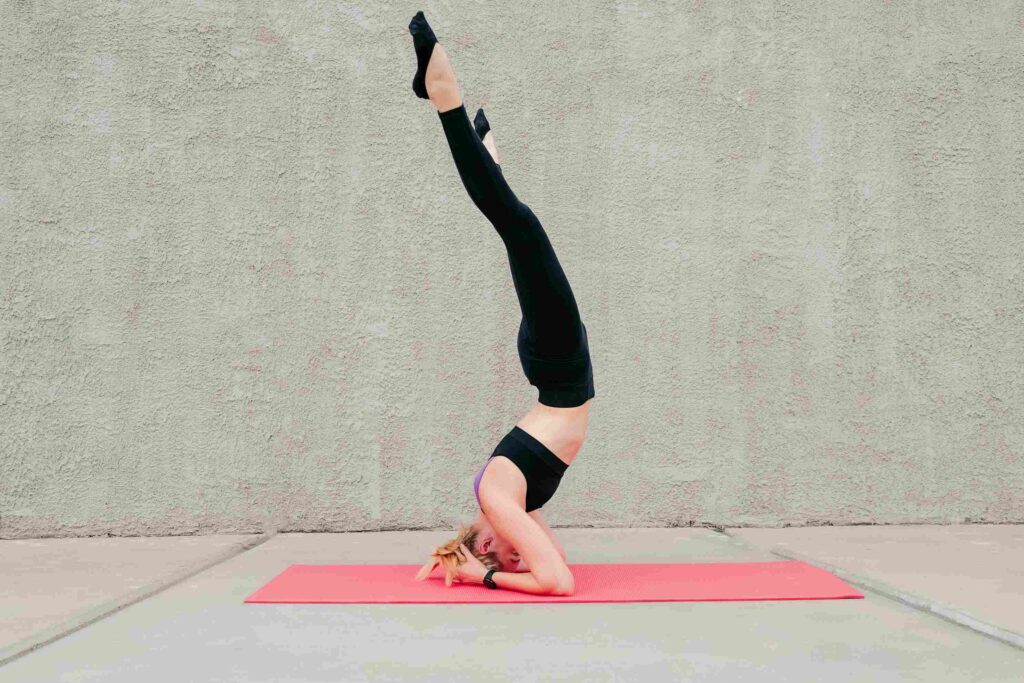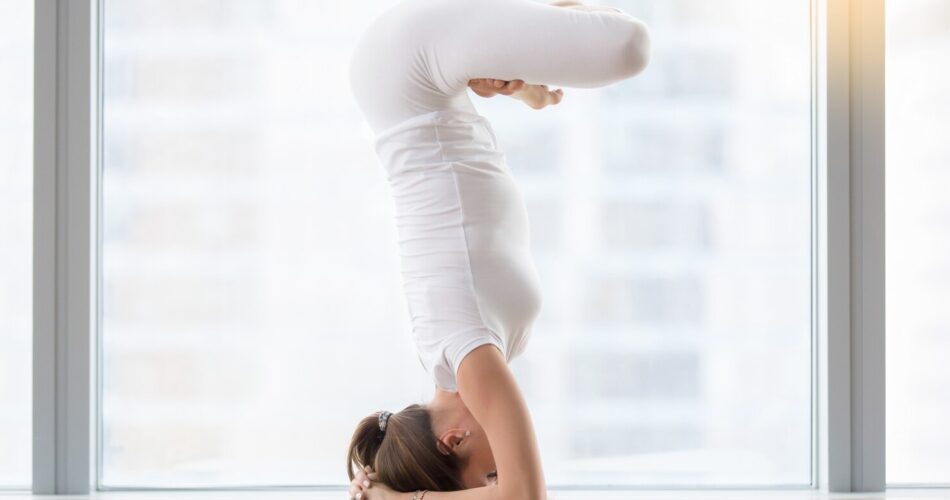How to properly stand on your head?
Correcting mistakes to achieve the right body position in a headstand is as difficult as learning Sirsasana for the first time. Therefore, it is important from the very beginning to adhere to the order of entering and exiting the pose, fully controlling the process.
Whether or not to master the asana is up to each individual, but the numerous benefits the body receives from the practice make the headstand appealing to yoga practitioners. The inverted asana helps take a new look at the surrounding reality, affirm one’s own capabilities, and boost self-confidence.

Benefits of the Headstand
The positive effects of the exercise on the body manifest as follows:
• Stimulation of brain regions eliminates migraines, normalizes the function of endocrine glands;
• The hormonal balance stabilizes, vision, memory, and attention improve;
• The likelihood of depression and nervous system disorders decreases;
• Metabolism is enhanced, aiding in weight loss;
• Improved blood flow supplies more oxygen to the brain and internal organs, reducing strain on the heart;
• The function of the digestive tract and abdominal organs is regulated;
• Muscles are strengthened, and diseases of the urinary system are healed.
Skills in coordination of movements acquired in Sirsasana change self-perception, boost self-esteem, stress tolerance, and awareness of actions.
Do not perform the asana if you have heart failure, atherosclerosis, cataracts, glaucoma, kidney diseases, herniated discs, and some other conditions. Practicing the headstand during pregnancy should be done under the supervision of an experienced instructor. Expectant mothers primarily think of the baby’s safety and full development. Therefore, it is useful to consider possible risks and consult a doctor before starting.

Headstand Technique
The exercise is recommended to be performed at least 3-4 hours after eating before the main complex of asanas, as the body should not be tired and tense when entering Sirsasana.
Sequence of Actions:
1. Kneel down, place your forearms on a folded blanket, with your elbows shoulder-width apart;
2. Interlace your fingers into a lock and hold them tightly, placing your palms on the edge of the blanket, touching it with your little fingers;
3. Move your knees closer to your elbows, place your head into the intertwined hands so that your fingers are on the back of your head, and the crown rests on the blanket;
4. Once your head is stable between your palms, lift your knees off the floor, balancing only on your toes;
5. Once stable, exhale and simultaneously lift your bent legs, holding the position;
6. Striving to maintain balance, gradually straighten your legs, extending your entire body into one line.
To exit the pose, gently repeat the same actions in reverse order.

Beginners are recommended to master the headstand technique with simplified variations:
• Perform the exercise in a corner, leaning both legs against two walls simultaneously to maintain balance and a symmetrical body position in the pose;
• Enter the headstand by lifting one leg while continuing to support the other leg on the mat. Once you learn to hold the pose with one leg raised, you can move on to the Shirshasana variation with both legs raised;
• Raise your legs with knees bent, pressing the thighs against the torso when in the top position, standing with bent legs. Once you master balance in this position, proceed to perform the classic Shirshasana.
If you experience discomfort or painful sensations in the body, you should immediately exit the asana. If you face difficulties with lifting and straightening the legs, headstand is practiced in simplified variations.

Exercise Nuances
1. When practicing Shirshasana, it’s important to continuously monitor your body position. Incorrect execution of this yoga pose and shifting the load can lead to injuries and harm your health.
2. The weight should be evenly distributed between the arms – forearms and hands. During the exercise, there should be a sensation that you can lift your head off the floor. Only about 30% of the weight should be on the head.
3. Lifting and lowering the legs together should be done slowly, on an exhale, without straining the abdomen.
4. The eyes should not be strained or bloodshot. Eye strain is a sign of incorrect exercise execution.
5. In Shirshasana, the elbows should be shoulder-width apart. Control the protrusion of the pelvis and abdomen, trying to align the body in one perpendicular line to the floor and direct it upwards.
The duration of a headstand in yoga practice is very individual. Beginners are recommended to hold the pose for half a minute, gradually increasing the duration to 10-15 minutes. Thorough preparation for learning the headstand will aid in a proper understanding of the pose’s technique, making yoga practice beneficial for health and safe.


Download the app and get 7 days free use
 eng
eng rus
rus deu
deu spa
spa fra
fra ita
ita por
por srp
srp tur
tur ukr
ukr por
por bos
bos

